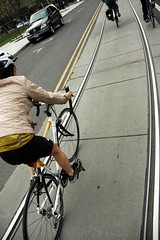
[Publisher’s note: This article is by BikePortland’s In-Depth reporter Libby Tucker. Tucker is a freelance journalist whose stories have been published by the Associated Press, MSNBC.com, The Oregonian, and others. She was most recently a staff writer for the Daily Journal of Commerce where she covered transportation, construction and energy. She is also the author of the blog, Naked Energy and is a regular contributor to the NYTimes.com blog, Green Inc. This will be a two-part story (read Part Two here).]
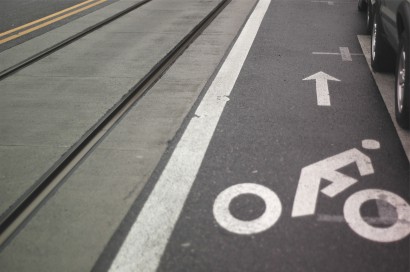
(Photos © J. Maus)
Where Bikes and Streetcar Collide
The eastside loop offers a lesson in Portland’s ever-evolving multi-modal Planning
A “Bikes and Transit” survey, conducted by Alta Planning and Design in October, revealed that more than 67 percent of 1,520 cyclists responding said they had crashed on streetcar or light rail tracks.
Riding home from her job in Northwest Portland last September, Catherine Halpin was thrown from her bike as she crossed NW 23rd Avenue where the streetcar tracks curve onto Lovejoy.
“I usually keep a heads up for the track,” said Halpin. “I don’t know if I just wasn’t paying attention or if it was my back tire.”
Halpin landed in the middle of the intersection on her elbow, which jammed the humerus bone upwards and broke her shoulder. She’s nearly healed and back on the bike but says she’ll never see the streetcar tracks the same way again.
“I’m pro public transportation, but I wince every time I see the yellow caution sign with a picture of the little person going over their handlebars,” said Halpin, a Northeast Portland resident. Even with the posted signs, she said, “I don’t think I realized what a hazard they were.”
Portland’s transportation planners, however, know full well the problem streetcar tracks pose to cyclists. As biking to work has gained popularity in Portland, growing from 2.7 percent of commuters in 1990 when the city initiated streetcar planning to 8 percent in 2008, according to the Portland Bureau of Transportation, so too have the number of bicyclists reporting tangles with the tracks.
A “Bikes and Transit” survey, conducted by Alta Planning and Design in October, revealed that more than 67 percent of 1,520 cyclists responding said they had crashed on streetcar or light rail tracks.
“We’re improving the design with each one we do… hopefully we’ll continue to seriously upgrade the design because it’s not good enough yet. It’s not even close.”
— Rick Gustafson, executive director of Portland Streetcar, Inc.
Portland still has no adopted guidelines or policies for streetcar design related to bicycles, but with each successive project, streetcar planners and designers have experimented with different solutions. The new eastside streetcar loop, for example – which is now in the final design stages and slated to open in 2011 – includes improvements such as a designated bike boulevard, a cycle track, bike signals and bike boxes to enhance safety and improve flow near the streetcar tracks along portions of the alignment.
But the city still has a long way to go to get back on track with other bike-forward cities, said Mia Birk, whose firm Alta Planning and Design consulted on the eastside loop project. Thorough bike planning only happened in one of four sections along the 3.3-mile extension, which will stretch from Northwest 10th Avenue and Lovejoy in the Pearl District over the Broadway Bridge to Northeast 7th Avenue, and then south through the Lloyd District to the Oregon Museum of Science and Industry along Martin Luther King Jr. Boulevard and Grand Avenue.
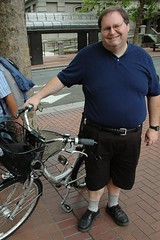
Portland Streetcar’s citizen
advisory committee. He’s working
hard to make sure bikes and
streetcars play nicely together.
The Pearl District will offer a fully integrated neighborhood design for bike facilities, while more moderate planning happened in a section of Northeast 7th Avenue, and tracks along the entire inner central eastside south of Interstate-84 won’t contain any additional bike facilities at all.
“We’re improving the design with each one we do and trying to find creative ways to deal with bike and streetcar conflicts,” said Rick Gustafson, executive director of Portland Streetcar Inc. “And hopefully we’ll continue to seriously upgrade the design because it’s not good enough yet. It’s not even close.”
The design team’s approach on the eastside loop was to identify four main areas of conflict for streetcar and bike interaction, said Gustafson, starting with the Pearl District, a designated “bike district” under the bike master plan now in development. The project marks the first time the city has hired an independent consultant to specifically help plan the interaction between bikes and the streetcar.
“The original alignment was relatively insensitive to bikes,” said Chris Smith, a member of the bicycle master plan committee and chairman of the Portland Streetcar’s citizen advisory committee. “We were just so focused on getting streetcar done that we didn’t bother with the details.”
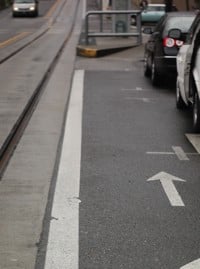
On NW Lovejoy, notice how the streetcar platform comes into the bike lane…
|
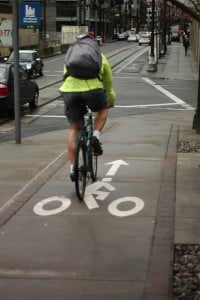
forcing riders up into the pedestrian area.
|
The classic problem along the Pearl District’s existing streetcar alignment is the streetcar platforms, which were stuck smack in the middle of the bike lane. The early solution was to reroute bikes onto the sidewalk behind the platform (ie Northwest 13th Avenue and Lovejoy), but that just created “chaos,” said Birk. It was a “valiant effort to find a solution,” she said. But, “we didn’t design it very well.”


